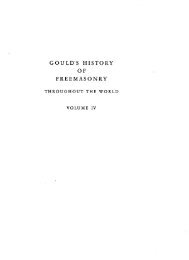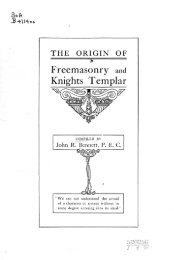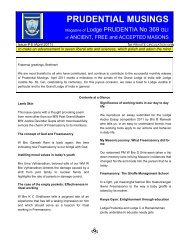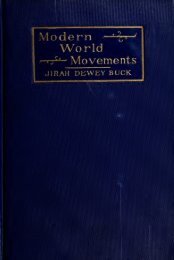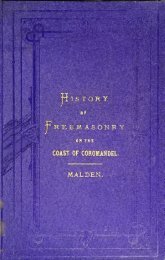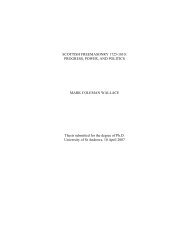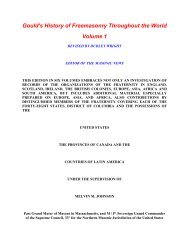- Page 1 and 2: Illustrations of Masonry - by Willi
- Page 3 and 4: Illustrations of Masonry - by Willi
- Page 5 and 6: Illustrations of Masonry - by Willi
- Page 7: Illustrations of Masonry - by Willi
- Page 11 and 12: Illustrations of Masonry - by Willi
- Page 13 and 14: Illustrations of Masonry - by Willi
- Page 15 and 16: Illustrations of Masonry - by Willi
- Page 17 and 18: Illustrations of Masonry - by Willi
- Page 19 and 20: Illustrations of Masonry - by Willi
- Page 21 and 22: Illustrations of Masonry - by Willi
- Page 23 and 24: Illustrations of Masonry - by Willi
- Page 25 and 26: Illustrations of Masonry - by Willi
- Page 27 and 28: Illustrations of Masonry - by Willi
- Page 29 and 30: Illustrations of Masonry - by Willi
- Page 31 and 32: Illustrations of Masonry - by Willi
- Page 33 and 34: Illustrations of Masonry - by Willi
- Page 35 and 36: Illustrations of Masonry - by Willi
- Page 37 and 38: Illustrations of Masonry - by Willi
- Page 39 and 40: Illustrations of Masonry - by Willi
- Page 41 and 42: Illustrations of Masonry - by Willi
- Page 43 and 44: Illustrations of Masonry - by Willi
- Page 45 and 46: Illustrations of Masonry - by Willi
- Page 47 and 48: Illustrations of Masonry - by Willi
- Page 49 and 50: Illustrations of Masonry - by Willi
- Page 51 and 52: Illustrations of Masonry - by Willi
- Page 53 and 54: Illustrations of Masonry - by Willi
- Page 55 and 56: Illustrations of Masonry - by Willi
- Page 57 and 58: Illustrations of Masonry - by Willi
- Page 59 and 60:
Illustrations of Masonry - by Willi
- Page 61 and 62:
Illustrations of Masonry - by Willi
- Page 63 and 64:
Illustrations of Masonry - by Willi
- Page 65 and 66:
Illustrations of Masonry - by Willi
- Page 67 and 68:
Illustrations of Masonry - by Willi
- Page 69 and 70:
Illustrations of Masonry - by Willi
- Page 71 and 72:
Illustrations of Masonry - by Willi
- Page 73 and 74:
Illustrations of Masonry - by Willi
- Page 75 and 76:
Illustrations of Masonry - by Willi
- Page 77 and 78:
Illustrations of Masonry - by Willi
- Page 79 and 80:
Illustrations of Masonry - by Willi
- Page 81 and 82:
Illustrations of Masonry - by Willi
- Page 83 and 84:
Illustrations of Masonry - by Willi
- Page 85 and 86:
Illustrations of Masonry - by Willi
- Page 87 and 88:
Illustrations of Masonry - by Willi
- Page 89 and 90:
Illustrations of Masonry - by Willi
- Page 91 and 92:
Illustrations of Masonry - by Willi
- Page 93 and 94:
Illustrations of Masonry - by Willi
- Page 95 and 96:
Illustrations of Masonry - by Willi
- Page 97 and 98:
Illustrations of Masonry - by Willi
- Page 99 and 100:
Illustrations of Masonry - by Willi
- Page 101 and 102:
Illustrations of Masonry - by Willi
- Page 103 and 104:
Illustrations of Masonry - by Willi
- Page 105 and 106:
Illustrations of Masonry - by Willi
- Page 107 and 108:
Illustrations of Masonry - by Willi
- Page 109 and 110:
Illustrations of Masonry - by Willi
- Page 111 and 112:
Illustrations of Masonry - by Willi
- Page 113 and 114:
Illustrations of Masonry - by Willi
- Page 115 and 116:
Illustrations of Masonry - by Willi
- Page 117 and 118:
Illustrations of Masonry - by Willi
- Page 119 and 120:
Illustrations of Masonry - by Willi
- Page 121 and 122:
Illustrations of Masonry - by Willi
- Page 123 and 124:
Illustrations of Masonry - by Willi
- Page 125 and 126:
12. for Montserrat.Illustrations of
- Page 127 and 128:
Illustrations of Masonry - by Willi
- Page 129 and 130:
Illustrations of Masonry - by Willi
- Page 131 and 132:
Illustrations of Masonry - by Willi
- Page 133 and 134:
Illustrations of Masonry - by Willi
- Page 135 and 136:
Illustrations of Masonry - by Willi
- Page 137 and 138:
Illustrations of Masonry - by Willi
- Page 139 and 140:
TranslationIllustrations of Masonry
- Page 141 and 142:
Illustrations of Masonry - by Willi
- Page 143 and 144:
Illustrations of Masonry - by Willi
- Page 145 and 146:
Illustrations of Masonry - by Willi
- Page 147 and 148:
Illustrations of Masonry - by Willi
- Page 149 and 150:
Illustrations of Masonry - by Willi
- Page 151 and 152:
Illustrations of Masonry - by Willi
- Page 153 and 154:
Music — Clergy.Illustrations of M
- Page 155 and 156:
Illustrations of Masonry - by Willi
- Page 157 and 158:
Illustrations of Masonry - by Willi
- Page 159 and 160:
Illustrations of Masonry - by Willi
- Page 161 and 162:
Illustrations of Masonry - by Willi
- Page 163 and 164:
Illustrations of Masonry - by Willi
- Page 165 and 166:
Illustrations of Masonry - by Willi
- Page 167 and 168:
Illustrations of Masonry - by Willi
- Page 169 and 170:
Illustrations of Masonry - by Willi
- Page 171 and 172:
Illustrations of Masonry - by Willi
- Page 173 and 174:
Illustrations of Masonry - by Willi
- Page 175 and 176:
Illustrations of Masonry - by Willi
- Page 177 and 178:
Illustrations of Masonry - by Willi
- Page 179 and 180:
Illustrations of Masonry - by Willi
- Page 181 and 182:
Illustrations of Masonry - by Willi
- Page 183 and 184:
Illustrations of Masonry - by Willi
- Page 185 and 186:
Illustrations of Masonry - by Willi
- Page 187 and 188:
Illustrations of Masonry - by Willi
- Page 189 and 190:
Illustrations of Masonry - by Willi
- Page 191 and 192:
Abash'd hoarse jarring atoms heard,
- Page 193 and 194:
Illustrations of Masonry - by Willi
- Page 195 and 196:
Illustrations of Masonry - by Willi
- Page 197 and 198:
Illustrations of Masonry - by Willi
- Page 199 and 200:
No lowen, no lowen our secrets can
- Page 201 and 202:
All climates are their native home,
- Page 203 and 204:
Illustrations of Masonry - by Willi
- Page 205 and 206:
Illustrations of Masonry - by Willi
- Page 207 and 208:
Illustrations of Masonry - by Willi
- Page 209 and 210:
Illustrations of Masonry - by Willi
- Page 211 and 212:
Illustrations of Masonry - by Willi
- Page 213 and 214:
Illustrations of Masonry - by Willi
- Page 215 and 216:
Illustrations of Masonry - by Willi
- Page 217 and 218:
Antiquity's prideWe have on our sid
- Page 219 and 220:
Illustrations of Masonry - by Willi
- Page 221 and 222:
Illustrations of Masonry - by Willi
- Page 223 and 224:
Sweet Friendship tooHer smiles with
- Page 225 and 226:
SONG XXX.Illustrations of Masonry -
- Page 227 and 228:
Illustrations of Masonry - by Willi
- Page 229 and 230:
Illustrations of Masonry - by Willi
- Page 231 and 232:
for less than seaven years. And tha
- Page 233 and 234:
who first took down the examination
- Page 235 and 236:
other angels, to the number of thre
- Page 237 and 238:
That when the Master and Wardens me
- Page 239 and 240:
it cannot derogate from the honour
- Page 241 and 242:
16th October 1646.' In another plac
- Page 243 and 244:
It is a question that will admit of
- Page 245 and 246:
EUROPAMHONORES OCCUPAVERATNOMEN LAT
- Page 247 and 248:
cxxiiThe particulars of this part o



